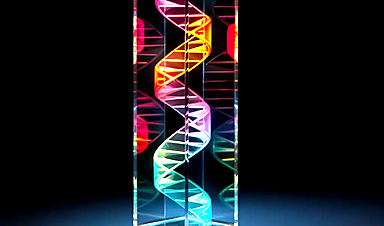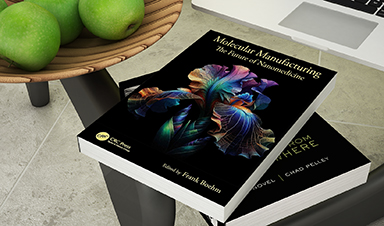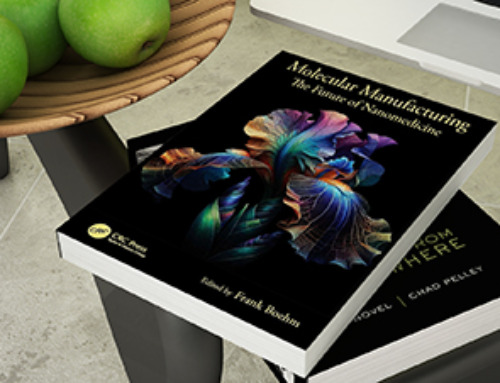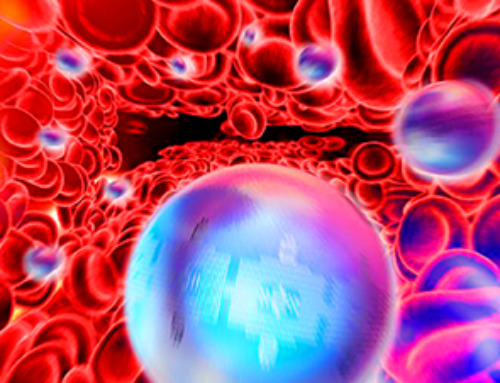Researchers developed a light yet strong material by combining two unexpected ingredients—DNA and glass.
Working at the nanoscale provides scientists with a deep understanding and precision in crafting and analyzing materials. In broader-scale production, and even in natural settings, numerous materials are susceptible to defects and contaminants that can compromise their intricate architecture. Such vulnerabilities can cause them to fracture under pressure. This is particularly evident in most types of glass, leading to its reputation as a fragile material.
Scientists at the Columbia University, the University of Connecticut, and the U.S. Department of Energy's (DOE) Brookhaven National Laboratory were able to fabricate a pure form of glass and coat specialized pieces of DNA with it to create a material that was not only stronger than steel, but incredibly lightweight. Materials that possess both of these qualities are uncommon, and further research could lead to novel engineering and defense applications. The results were published in the journal Cell Reports Physical Science.
DNA—The Building Blocks for Life and More
In living things, deoxyribonucleic acid, more commonly known as DNA, carries biological information that instructs the cells of organisms on how to form, grow, and reproduce. The material DNA is made of is known as a polymer, a class of tough, elastic materials that includes plastic and rubber. Their resilience and simplicity have intrigued material scientists and inspired many interesting experiments. Oleg Gang, a materials scientist at the Center for Functional Nanomaterials (CFN), a DOE Office of Science User Facility at Brookhaven Lab, and a professor at Columbia University, has been leveraging DNA's unique properties for materials synthesis for years, resulting in numerous discoveries. This novel technology has inspired an array of innovative applications—from drug delivery to electronics.
These blocks then cling together to form a larger lattice—a structure with a repeating pattern. This process allows scientists to build 3D-ordered nanomaterials from DNA and integrate inorganic nanoparticles and proteins, as demonstrated by the group's previous studies. After gaining an understanding and control of this unique assembly process, Gang, Michelson, and their team were then able to explore what could be achieved when that biomolecular scaffolding was used to create silica frameworks that preserve the scaffold architecture.
"We focused on using DNA as a programmable nanomaterial to form a complex 3D scaffold," said Michelson, "and we wanted to explore how this scaffold will perform mechanically when transferred into more stable solid-state materials. We explored having this self-assembling material cast in silica, the main ingredient in glass, and its potential."
Michelson's work in this field earned him the Robert Simon Memorial Prize at Columbia University. His research into DNA frameworks has explored a range of characteristics and applications, from mechanical properties to superconductivity. Much like the structures he's built upon, Michelson's work continues to grow and build as it takes on new layers of information from these exciting experiments.

A microscopic peek of how these DNA strands form shapes that are built into larger lattice structures that are coated in silica. CFN, JEOL-1400 TEM, and Hitachi-4800 SEM. Credit: Brookhaven National Laboratory
"We were very interested to explore how we can enhance mechanical properties of regular materials, like glass, but structuring them at the nanoscale," said Gang.
The scientists used a very thin layer of silica glass, only about 5 nm or a few hundred atoms thick, to coat the DNA frames, leaving inner spaces open and ensuring that the resulting material is ultra-light. On this small scale, the glass is insensitive to flaws or defects, providing a strength that isn't seen in larger pieces of glass where cracks develop and cause it to shatter. The team wanted to know exactly how strong this material was though, which, at this scale, required some very specialized equipment.
Strength Under Pressure
There are simple ways to check if something is sturdy. Poking, pushing, and leaning on surfaces and observing their behavior can often provide helpful information. Do they bend, creak, buckle, or stand firm under the stress? This is a simple, but effective way to get an understanding of an object's strength, even without tools to measure it precisely. How does one press on an object that's too small to see, though?
"To measure the strength of these tiny structures, we employed a technique called nanoindentation," explained Michelson. "Nanoindentation is a mechanical test on a very small scale performed using a precise instrument that can apply and measure resistive forces. Our samples are only a few microns thick, about a thousandth of a millimeter, so it's impossible to measure these materials by conventional means. Using an electron microscope and nanoindentation together, we can simultaneously measure mechanical behavior and observe the process of the compression."

A graph comparing the nanolattice in this experiment to the relative strength of various materials. Credit: Brookhaven National Laboratory
As the tiny device compresses, or indents, the sample, researchers can take measurements and observe mechanical properties. They can then see what happens to the material as the compression is released and the sample returns to its original state. If there are any cracks that form or if the structure fails at any point, this valuable data can be recorded.
When put to the test, the glass-coated DNA lattice was shown to be four times stronger than steel! What was even more interesting was that its density was about five times lower. While there are materials that are strong and considered fairly lightweight, it has never been achieved to this degree.
This technique wasn't something that was always readily available at CFN, however.
"We collaborated with Seok-Woo Lee, an associate professor at the University of Connecticut, who has expertise in the mechanical properties of materials," said Gang. "He was a CFN user who leveraged some of our capabilities and resources, like electron microscopes, which is how we developed a relationship with him. We initially didn't have the capability for nanoindentation, but he led us to the proper tools and got us on the right track. This is another example of how scientists from academia and national labs benefit from working together. We now have these tools and the expertise to take studies like this even further."
Building Something New and Exciting
While there is still a lot of work to be done before scaling up and thinking about the myriad of applications for such a material, there are still reasons for materials scientists to be excited about what this means going forward. The team plans to look at other materials, like carbide ceramics, that are even stronger than glass to see how they work and behave. This could lead to even stronger lightweight materials in the future.
While his career is still in its early stages, Michelson has already achieved so much and is already eager to start on the next phases of his research.
"It's a wonderful opportunity to be a postdoc at Brookhaven Lab, especially after being a Columbia University student who would work at the CFN quite often," recalled Michelson. "This is what led me to continue there as a postdoc. The capabilities that we have at the CFN, especially in regard to imaging, really helped to propel my work."
Reference: "High-strength, lightweight nano-architected silica" by Aaron Michelson, Tyler J. Flanagan, Seok-Woo Lee and Oleg Gang, 27 June 2023, Cell Reports Physical Science.
DOI: 10.1016/j.xcrp.2023.101475
News
Two New Books From Frank Boehm, NA Founder – To be Released Dec. 2025
Molecular Manufacturing: The Future of Nanomedicine This book explores the revolutionary potential of atomically precise manufacturing technologies to transform global healthcare, as well as practically every other sector across society. This forward-thinking volume examines [...]
What could the future of nanoscience look like?
Society has a lot to thank for nanoscience. From improved health monitoring to reducing the size of electronics, scientists’ ability to delve deeper and better understand chemistry at the nanoscale has opened up numerous [...]
Scientists Melt Cancer’s Hidden “Power Hubs” and Stop Tumor Growth
Researchers discovered that in a rare kidney cancer, RNA builds droplet-like hubs that act as growth control centers inside tumor cells. By engineering a molecular switch to dissolve these hubs, they were able to halt cancer [...]
Platelet-inspired nanoparticles could improve treatment of inflammatory diseases
Scientists have developed platelet-inspired nanoparticles that deliver anti-inflammatory drugs directly to brain-computer interface implants, doubling their effectiveness. Scientists have found a way to improve the performance of brain-computer interface (BCI) electrodes by delivering anti-inflammatory drugs directly [...]
After 150 years, a new chapter in cancer therapy is finally beginning
For decades, researchers have been looking for ways to destroy cancer cells in a targeted manner without further weakening the body. But for many patients whose immune system is severely impaired by chemotherapy or radiation, [...]
Older chemical libraries show promise for fighting resistant strains of COVID-19 virus
SARS‑CoV‑2, the virus that causes COVID-19, continues to mutate, with some newer strains becoming less responsive to current antiviral treatments like Paxlovid. Now, University of California San Diego scientists and an international team of [...]
Lower doses of immunotherapy for skin cancer give better results, study suggests
According to a new study, lower doses of approved immunotherapy for malignant melanoma can give better results against tumors, while reducing side effects. This is reported by researchers at Karolinska Institutet in the Journal of the National [...]
Researchers highlight five pathways through which microplastics can harm the brain
Microplastics could be fueling neurodegenerative diseases like Alzheimer's and Parkinson's, with a new study highlighting five ways microplastics can trigger inflammation and damage in the brain. More than 57 million people live with dementia, [...]
Tiny Metal Nanodots Obliterate Cancer Cells While Largely Sparing Healthy Tissue
Scientists have developed tiny metal-oxide particles that push cancer cells past their stress limits while sparing healthy tissue. An international team led by RMIT University has developed tiny particles called nanodots, crafted from a metallic compound, [...]
Gold Nanoclusters Could Supercharge Quantum Computers
Researchers found that gold “super atoms” can behave like the atoms in top-tier quantum systems—only far easier to scale. These tiny clusters can be customized at the molecular level, offering a powerful, tunable foundation [...]
A single shot of HPV vaccine may be enough to fight cervical cancer, study finds
WASHINGTON -- A single HPV vaccination appears just as effective as two doses at preventing the viral infection that causes cervical cancer, researchers reported Wednesday. HPV, or human papillomavirus, is very common and spread [...]
New technique overcomes technological barrier in 3D brain imaging
Scientists at the Swiss Light Source SLS have succeeded in mapping a piece of brain tissue in 3D at unprecedented resolution using X-rays, non-destructively. The breakthrough overcomes a long-standing technological barrier that had limited [...]
Scientists Uncover Hidden Blood Pattern in Long COVID
Researchers found persistent microclot and NET structures in Long COVID blood that may explain long-lasting symptoms. Researchers examining Long COVID have identified a structural connection between circulating microclots and neutrophil extracellular traps (NETs). The [...]
This Cellular Trick Helps Cancer Spread, but Could Also Stop It
Groups of normal cbiells can sense far into their surroundings, helping explain cancer cell migration. Understanding this ability could lead to new ways to limit tumor spread. The tale of the princess and the [...]
New mRNA therapy targets drug-resistant pneumonia
Bacteria that multiply on surfaces are a major headache in health care when they gain a foothold on, for example, implants or in catheters. Researchers at Chalmers University of Technology in Sweden have found [...]
Current Heart Health Guidelines Are Failing To Catch a Deadly Genetic Killer
New research reveals that standard screening misses most people with a common inherited cholesterol disorder. A Mayo Clinic study reports that current genetic screening guidelines overlook most people who have familial hypercholesterolemia, an inherited disorder that [...]





















